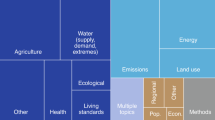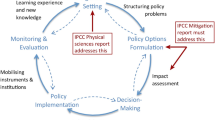Abstract
Discussions on a long-term global goal to limit climate change, in the form of an upper limit to warming, were only partially resolved at the United Nations Framework Convention on Climate Change negotiations in Paris, 2015. Such a political agreement must be informed by scientific knowledge. One way to communicate the costs and benefits of policies is through a mapping that systematically explores the consequences of different choices. Such a multi-disciplinary effort based on the analysis of a set of scenarios helped structure the IPCC AR5 Synthesis Report. This Perspective summarizes this approach, reviews its strengths and limitations, and discusses how decision-makers can use its results in practice. It also identifies research needs that can facilitate integrated analysis of climate change and help better inform policy-makers and the public.
This is a preview of subscription content, access via your institution
Access options
Subscribe to this journal
Receive 12 print issues and online access
$209.00 per year
only $17.42 per issue
Buy this article
- Purchase on Springer Link
- Instant access to full article PDF
Prices may be subject to local taxes which are calculated during checkout

Similar content being viewed by others
References
IPCC Climate Change 2014: Synthesis Report (eds Pachauri, R. K. & Meyer, L. A.) (Cambridge Univ. Press, 2014).
Knutti, R., Rogelj, J., Sedláček, J. & Fischer, E. M. A scientific critique of the two-degree climate change target. Nature Geosci. 9, 13–18 (2016).
Edenhofer, O. & Minx, J. Mapmakers and navigators, facts and values. Science 345, 37–38 (2014).
IPCC Climate Change 2014: Impacts, Adaptation, and Vulnerability. Part A: Global and Sectoral Aspects (eds Field, C. B. et al.) (Cambridge Univ. Press, 2014).
IPCC Climate Change 2013: The Physical Science Basis (eds Stocker, T. F. et al.) (Cambridge Univ. Press, 2013).
IPCC Climate Change 2014: Mitigation of Climate Change (eds Edenhofer, O. et al.) (Cambridge Univ. Press, 2014).
Clark, P. U. et al. Consequences of twenty-first-century policy for multi-millennial climate and sea-level change. Nature Clim. Change 6, 360–369 (2016).
Rogelj, J. et al. Energy system transformations for limiting end-of-century warming to below 1.5 °C. Nature Clim. Change 5, 519–527 (2015).
Ha-Duong, M., Grubb, M. J. & Hourcade, J.-C. Influence of socioeconomic inertia and uncertainty on optimal CO2-emission abatement. Nature 390, 270–273 (1997).
Lempert, R. J. & Schlesinger, M. E. Robust strategies for abating climate change. Climatic Change 45, 387–401 (2000).
Yohe, G., Andronova, N. & Schlesinger, M. To hedge or not against an uncertain climate future? Science 306, 416–417 (2004).
Clarke, L. et al. in Climate Change 2014: Mitigation of Climate Change (eds Edenhofer, O. et al.) Ch. 6 (IPCC, Cambridge Univ. Press, 2014).
van Vuuren, D. P. & Riahi, K. The relationship between short-term emissions and long-term concentration targets. Climatic Change 104, 793–801 (2010).
Smith, P. et al. Biophysical and economic limits to negative CO2 emissions. Nature Clim. Change 6, 42–50 (2016).
Williamson, P. Emissions reduction: scrutinize CO2 removal methods. Nature 530, 153–155 (2016).
Fawcett, A. A. et al. Can Paris pledges avert severe climate change? Science 350, 1168–1169 (2015).
Otto, F. E. L., Frame, D. J., Otto, A. & Allen, M. R. Embracing uncertainty in climate change policy. Nature Clim. Change 5, 917–920 (2015).
Kriegler, E. et al. Introduction to the AMPERE model intercomparison studies on the economics of climate stabilization. Technol. Forecast. Soc. 90, 1–7 (2015).
Luderer, G. et al. Economic mitigation challenges: how further delay closes the door for achieving climate targets. Environ. Res. Lett. 8, 34033 (2013).
Rogelj, J., McCollum, D. L., O'Neill, B. C. & Riahi, K. 2020 emissions levels required to limit warming to below 2 °C. Nature Clim. Change 3, 405–412 (2013).
von Stechow, C., Minx, J. C. & Riahi, K. 2 °C and the sustainable development goals: united they stand, divided they fall? Environ. Res. Lett. 11, 034022 (2015).
Guivarch, C. & Hallegatte, S. 2C or not 2C? Glob. Environ. Change 23, 179–192 (2013).
Pfister, P. L. & Stocker, T. F. Earth system commitments due to delayed mitigation. Environ. Res. Lett. 11, 14010 (2016).
Stocker, T. F. The closing door of climate targets. Science 339, 280–282 (2013).
Rogelj, J. et al. Disentangling the effects of CO2 and short-lived climate forcer mitigation. Proc. Natl Acad. Sci. USA 111, 16325–16330 (2014).
van Vuuren, D. P., Weyant, J. & de la Chesnaye, F. Multi-gas scenarios to stabilize radiative forcing. Energ. Econ. 28, 102–120 (2006).
Lenton, T. M. Environmental tipping points. Annu. Rev. Environ. Resour. 38, 1–29 (2013).
Stocker, T. F. & Schmittner, A. Influence of CO2 emission rates on the stability of the thermohaline circulation. Nature 388, 862–865 (1997).
Steinacher, M., Joos, F. & Stocker, T. F. Allowable carbon emissions lowered by multiple climate targets. Nature 499, 197–201 (2013).
McCollum, D. L. et al. Climate policies can help resolve energy security and air pollution challenges. Climatic Change 119, 479–494 (2013).
von Stechow, C. et al. Integrating global climate change mitigation goals with other sustainability objectives: a synthesis. Annu. Rev. Environ. Resour. 40, 363–394 (2015).
Hallegatte, S. et al. Shock Waves: Managing the Impacts of Climate Change on Poverty (World Bank, 2016).
O'Neill, B. C. et al. A new scenario framework for climate change research: the concept of shared socioeconomic pathways. Climatic Change 122, 387–400 (2013).
Vuuren, D. P. van. et al. A new scenario framework for climate change research: scenario matrix architecture. Climatic Change 122, 373–386 (2013).
Acknowledgements
This paper benefited from many discussions with all the authors of the AR5 Synthesis Report of the IPCC, many authors from the three Working Groups, and members from the government delegations during the approval plenary in Copenhagen, 2014. Marianne Fay, Jan Fuglestvedt and Brian O'Neill provided useful comment on previous versions of the manuscript.
Author information
Authors and Affiliations
Contributions
All authors contributed to the assessment of the literature, the design of the figure and concepts and the writing of the paper.
Corresponding author
Ethics declarations
Competing interests
The authors declare no competing financial interests.
Rights and permissions
About this article
Cite this article
Hallegatte, S., Rogelj, J., Allen, M. et al. Mapping the climate change challenge. Nature Clim Change 6, 663–668 (2016). https://doi.org/10.1038/nclimate3057
Received:
Accepted:
Published:
Issue Date:
DOI: https://doi.org/10.1038/nclimate3057
This article is cited by
-
Green infrastructure in cities for the achievement of the un sustainable development goals: a systematic review
Urban Ecosystems (2023)
-
Deduction of sudden rainstorm scenarios: integrating decision makers' emotions, dynamic Bayesian network and DS evidence theory
Natural Hazards (2023)
-
An Oligopoly Game of CDR Strategy Deployment in a Steady-State Net-Zero Emission Climate Regime
Environmental Modeling & Assessment (2021)
-
Paris Climate Agreement passes the cost-benefit test
Nature Communications (2020)
-
Negations in uncertainty lexicon affect attention, decision-making and trust
Climatic Change (2020)



